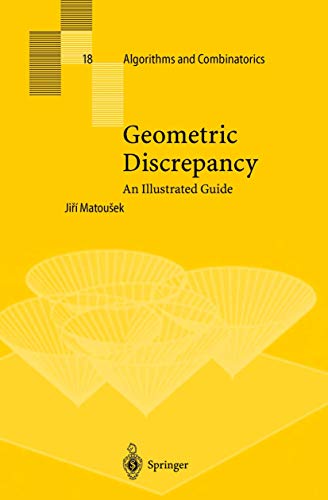
Synopsis
Discrepancy theory is also called the theory of irregularities of distribution. Here are some typical questions: What is the "most uniform" way of dis tributing n points in the unit square? How big is the "irregularity" necessarily present in any such distribution? For a precise formulation of these questions, we must quantify the irregularity of a given distribution, and discrepancy is a numerical parameter of a point set serving this purpose. Such questions were first tackled in the thirties, with a motivation com ing from number theory. A more or less satisfactory solution of the basic discrepancy problem in the plane was completed in the late sixties, and the analogous higher-dimensional problem is far from solved even today. In the meantime, discrepancy theory blossomed into a field of remarkable breadth and diversity. There are subfields closely connected to the original number theoretic roots of discrepancy theory, areas related to Ramsey theory and to hypergraphs, and also results supporting eminently practical methods and algorithms for numerical integration and similar tasks. The applications in clude financial calculations, computer graphics, and computational physics, just to name a few. This book is an introductory textbook on discrepancy theory. It should be accessible to early graduate students of mathematics or theoretical computer science. At the same time, about half of the book consists of material that up until now was only available in original research papers or in various surveys.
"synopsis" may belong to another edition of this title.
From the Back Cover
What is the "most uniform" way of distributing n points in the unit square? How big is the "irregularity" necessarily present in any such distribution? Such questions are treated in geometric discrepancy theory. The book is an accessible and lively introduction to this area, with numerous exercises and illustrations. In separate, more specialized parts, it also provides a comprehensive guide to recent research. Including a wide variety of mathematical techniques (from harmonic analysis, combinatorics, algebra etc.) in action on non-trivial examples, the book is suitable for a "special topic" course for early graduates in mathematics and computer science. Besides professional mathematicians, it will be of interest to specialists in fields where a large collection of objects should be "uniformly" represented by a smaller sample (such as high-dimensional numerical integration in computational physics or financial mathematics, efficient divide-and-conquer algorithms in computer science, etc.).
From the reviews: "...The numerous illustrations are well placed and instructive. The clear and elegant exposition conveys a wealth of intuitive insights into the techniques utilized. Each section usually consists of text, historical remarks and references for the specialist, and exercises. Hints are provided for the more difficult exercises, with the exercise-hint format permitting inclusion of more results than otherwise would be possible in a book of this size..."
Allen D. Rogers, Mathematical Reviews Clippings (2001)
"About this title" may belong to another edition of this title.
Other Popular Editions of the Same Title
Search results for Geometric Discrepancy: An Illustrated Guide: 18 (Algorithms...
Geometric Discrepancy: An Illustrated Guide (Algorithms and Combinatorics, 18)
Seller: HPB-Red, Dallas, TX, U.S.A.
hardcover. Condition: Good. Connecting readers with great books since 1972! Used textbooks may not include companion materials such as access codes, etc. May have some wear or writing/highlighting. We ship orders daily and Customer Service is our top priority! Seller Inventory # S_446844065
Geometric discrepancy. An illustrated guide Ji?í Matou ek. Algorithms and combinatorics 18.
Seller: Antiquariat Bookfarm, Löbnitz, Germany
Hardcover. Ex-library with stamp and library-signature. GOOD condition, some traces of use. Ancien Exemplaire de bibliothèque avec signature et cachet. BON état, quelques traces d'usure. Ehem. Bibliotheksexemplar mit Signatur und Stempel. GUTER Zustand, ein paar Gebrauchsspuren. 11 MAT 9783540655282 Sprache: Englisch Gewicht in Gramm: 550. Seller Inventory # 2502011
Geometric Discrepancy - An Illustrated Guide
Seller: Romtrade Corp., STERLING HEIGHTS, MI, U.S.A.
Condition: New. This is a Brand-new US Edition. This Item may be shipped from US or any other country as we have multiple locations worldwide. Seller Inventory # ABNR-86175
Geometric Discrepancy - An Illustrated Guide
Seller: Basi6 International, Irving, TX, U.S.A.
Condition: Brand New. New. US edition. Expediting shipping for all USA and Europe orders excluding PO Box. Excellent Customer Service. Seller Inventory # ABEOCT25-242179
Geometric discrepancy an illustrated guide Ji?í Matou ek. Algorithms and combinatorics 18.
Seller: Antiquariat Bookfarm, Löbnitz, Germany
Hardcover. Ex-library with stamp and library-signature. GOOD condition, some traces of use. Ancien Exemplaire de bibliothèque avec signature et cachet. BON état, quelques traces d'usure. Ehem. Bibliotheksexemplar mit Signatur und Stempel. GUTER Zustand, ein paar Gebrauchsspuren. 11 MAT 9783540655282 Sprache: Englisch Gewicht in Gramm: 1150. Seller Inventory # 2505767
Geometric Discrepancy
Seller: Books Puddle, New York, NY, U.S.A.
Condition: New. pp. 306. Seller Inventory # 26351745
Geometric Discrepancy
Seller: Majestic Books, Hounslow, United Kingdom
Condition: New. pp. 306 52:B&W 6.14 x 9.21in or 234 x 156mm (Royal 8vo) Case Laminate on White w/Gloss Lam. Seller Inventory # 7528926
Geometric Discrepancy: An Illustrated Guide (Algorithms and Combinatorics, 18)
Seller: Best Price, Torrance, CA, U.S.A.
Condition: New. SUPER FAST SHIPPING. Seller Inventory # 9783540655282
Geometric Discrepancy
Seller: Biblios, Frankfurt am main, HESSE, Germany
Condition: New. pp. 306. Seller Inventory # 18351755
Geometric Discrepancy: An Illustrated Guide (Algorithms and Combinatorics, 18)
Seller: Lucky's Textbooks, Dallas, TX, U.S.A.
Condition: New. Seller Inventory # ABLIING23Mar3113020173806

